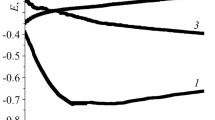Abstract
Partial polarization curves at the glassy carbon rotating disc electrode have been used to study the electrodeposition of Ni and Ni-W alloy from citrate-containing solution. For deposition of Ni-W alloys, the partial polarization curves indicate diffusion control for nickel reduction and stoichiometric limitation for tungsten deposition by the composition of the alloy. Plating experiments show that current efficiency of the electrodeposition and composition of the resulting alloy depend on the parameters of the electrolysis. The best conditions for electrodeposition of the alloy Ni-W-B are current density of 45–50 mA cm−2, temperature of 60–70 °C, Ni(II) concentration of 20–25 mm, and pH 8.5. Pulsed galvanostatic plating at 1 Hz increased slightly the current efficiency. The concentration of Ni(II) in the solution can be self-regulated by using a nickel bipolar electrode in the cathode compartment.
Similar content being viewed by others
References
W. Klement Jr., R. H. Willens and P. Duwez, Nature (UK) 187 (1960) 869.
Yu. M. Polukarov and V. V. Bondar, Dokl. Akad. Nauk SSSR 123 (1958) 720.
A. Szasz, D. J. Fabian, Z. Paal and J. Kojnok, J. Non Cryst. Solids 103 (1988) 21.
Y. Akahama, Y. Mori, M. Kobayashi, H. Kawamura, K. Kimura and S. Takeuchi, J. Phys. Soc. Jpn. 58 (1989) 2231.
V. M. Knyazheva, E. A. Ul'ianin and L. A. Yanov, Itogi Nauki, Tekh. Ser. Korroz. Zashch. Korroz. 9 (1982) 225.
M. Naka, K. Hashimoto, K. Asami and T. Masumoto, in ‘Rapidly quenched metals’, (edited by B. Cantor), Proc. Int. Conf. 3rd Met. Soc., London, vol. 2 (1978) p. 449.
C. A. Pampillo, J. Mater. Sci. 10 (1975) 1194.
G. A. Croopnik and D. M. Scruggs, US Patent 4529668 (16 July 1985).
M. Donten and J. Osteryoung, J. Appl. Electrochem. 21 (1991) 496.
K. Wikiel and J. Osteryoung, ibid. 22 (1992) 506.
M. Donten, Z. Stojek and J. Osteryoung, J. Electrochem. Soc. 140 (1993) 3417.
E. Chassing, K. Vu Quang and R. Wiart, J. Appl. Electrochem. 18 (1989) 839.
R. Wiart, Electrochim. Acta 35 (1990) 1587.
Private communication, Amorphous metals Technologies, Inc.
I. M. Kolthoff and J. J. Lingne, ‘Polarography’, Interscience Publishers, New York (1965), p. 487.
M. Hancen, ‘Constitution of binary alloys’ McGraw-Hill, New York (1958), p. 1057.
S. Grilikhes and K. Tikhonov, ‘Electrolytic and electroless deposits’ (in Russian), Chemistry, Leningrad (1990), p. 288.
A. Rotinian, K. Tikhonov and I. Shoshina, ‘Theoretical electrochemistry’ (in Russian), Chemistry, Leningrad (1981) p. 160.
J. Bockris and R. Parsons, Trans. Faraday Soc. 44 (1948) 860.
A. Brenner, ‘Electrodeposition of alloys’, Academic Press, New York and London, vol. 2 (1963), p. 429.
T. Alekhina, I. Shoshina, B. Karbasov, Russian J. Electrochem. 30 (1994) 241.
Author information
Authors and Affiliations
Rights and permissions
About this article
Cite this article
Isaev, N., Osteryoung, J.G. Electrodeposition of Ni-W-B amorphous alloys. J Appl Electrochem 25, 1091–1097 (1995). https://doi.org/10.1007/BF00242535
Received:
Issue Date:
DOI: https://doi.org/10.1007/BF00242535




